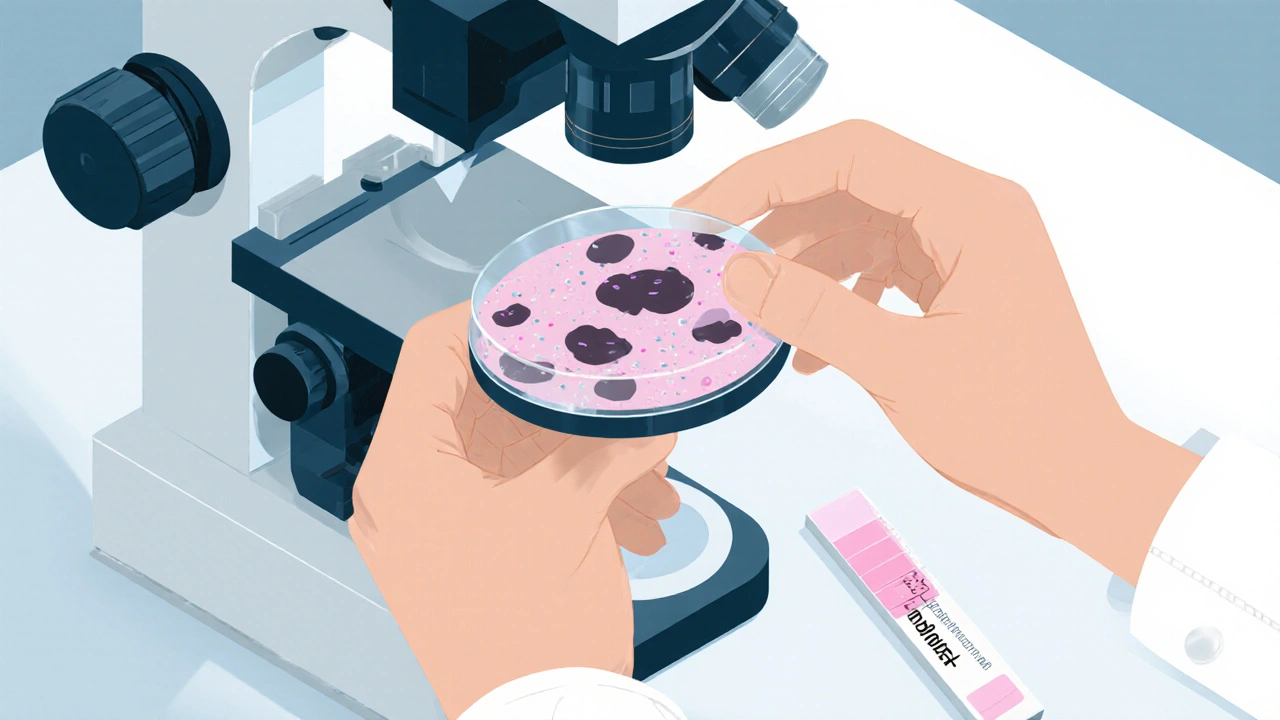Bacterial Vaginosis Symptom Checker
Check for Common BV Symptoms
Answer the following questions to assess your symptoms:
Your Risk Assessment
Click "Check My Symptoms" to assess your risk level.
Imagine waking up with a sudden, fishy odor and unusual discharge. You might brush it off, but those signs could point to bacterial vaginosis (BV), the most common vaginal infection in women of reproductive age. Knowing exactly when to call a clinician and what treatments work can spare you weeks of discomfort and prevent complications down the line.
TL;DR - Quick Takeaways
- Bacterial vaginosis is caused by an imbalance between Lactobacillus (good bacteria) and other anaerobes like Gardnerella vaginalis.
- Typical symptoms: thin gray‑white discharge, fishy smell, itching or burning after sex.
- Seek medical advice if you have persistent symptoms, pain, fever, or are pregnant.
- Diagnosis relies on Amsel criteria or Nugent score.
- First‑line treatment: a short course of metronidazole or clindamycin; probiotics can help prevent recurrence.
What Is Bacterial Vaginosis?
Bacterial Vaginosis is a shift in the normal vaginal ecosystem where protective Lactobacillus species drop, allowing anaerobic bacteria such as Gardnerella vaginalis, Prevotella and Mobiluncus to flourish. This imbalance raises the vaginal pH above the healthy range of 3.8‑4.5, creating the characteristic odor and discharge.
The condition isn’t a classic STI, but sexual activity can influence the bacterial mix. About 30% of women in the UK will experience BV at least once, and many have more than one episode.
Spotting the Signs - When to Call a Doctor
Most women notice a thin, gray‑white discharge that coats the vaginal walls. The smell, often described as “fishy,” intensifies after intercourse or during menstruation. Mild itching or a burning sensation during urination can accompany the discharge, though many report no itching at all.
While occasional odor isn’t a red flag, you should seek professional help if any of the following appear:
- Discharge persists for more than a week despite home hygiene measures.
- Pain during sex, pelvic pressure, or lower‑abdominal cramps.
- Fever, chills, or a foul‑smelling urine - these could signal a urinary tract infection or a more serious pelvic infection.
- You're pregnant or planning pregnancy - BV has been linked to preterm birth and low birth weight.
- You’ve tried over‑the‑counter products (e.g., yeast infection creams) with no improvement.
Quickly consulting a clinician reduces the risk of complications such as pelvic inflammatory disease (PID) or increased susceptibility to other STIs.
How Doctors Confirm BV - Diagnosis Tools
The gold‑standard diagnosis uses two methods. First, the Amsel criteria-a bedside assessment where a practitioner checks for:
- Homogeneous, thin, grayish discharge.
- Positive whiff test (a fishy odor when potassium hydroxide is added).
- Elevated vaginal pH (>4.5).
- Clue cells on a microscopic slide.
If at least three of these four signs appear, BV is likely.
The second, more detailed approach is the Nugent score. A lab technician grades a Gram‑stained sample on a 0‑10 scale based on the presence of Lactobacillus (score 0‑3), Gardnerella/Bacteroides (score 4‑6), and Mobiluncus (score 7‑10). A score of 7 or higher confirms BV.

Treatment Options - What Works Best?
Once diagnosed, the goal is to restore the healthy bacterial balance. The most reliable regimen is a short course of antibiotics, usually prescribed as a single dose or a 5‑day regimen.
| Medication | Formulation | Typical Dose | Effectiveness | Key Side‑effects |
|---|---|---|---|---|
| Metronidazole | Oral or gel | 500mg twice daily for 5days (oral) or 0.75% gel nightly for 5days | ≈85% cure rate | Nausea, metallic taste, rare headache |
| Clindamycin | Vaginal cream | 5% cream applied nightly for 7days | ≈80% cure rate | Local irritation, possible yeast overgrowth |
| Probiotics (LactobacillusrhamnosusGR‑1) | Oral capsule | 1billion CFU daily for 30days | Adjunct - reduces recurrence by ~30% | Generally well‑tolerated |
Metronidazole is the most commonly prescribed drug in the UK, available as a tablet or as a 0.75% vaginal gel. Clindamycin cream works well for women who experience nausea from oral meds. Probiotic supplements don’t cure an active episode but can bolster Lactobacillus after antibiotics, cutting down the odds of a repeat infection.
Never use antifungal creams meant for yeast infections; they won’t touch the anaerobic bacteria causing BV and may worsen the imbalance.
Preventing Recurrence - Lifestyle Tweaks That Help
About 50% of women with BV will have at least one more episode within a year. Here are evidence‑backed steps to keep the good bacteria in charge:
- Limit douching. Flushing the vagina removes Lactobacillus and encourages overgrowth of harmful species.
- Choose cotton underwear and breathable fabrics; tight synthetic wear can trap moisture and raise pH.
- Avoid smoking - nicotine disrupts the vaginal microbiome.
- Consider a probiotic regimen (e.g., LactobacillusrhamnosusGR‑1 or Lactobacillusreuteri) for a month after completing antibiotics.
- If you have multiple partners, discuss condom use. Condoms reduce the transfer of BV‑associated bacteria.
Women with a history of recurrent BV sometimes benefit from a “maintenance” dose of metronidazole-150mg twice weekly for three months-but this should only be done under a clinician’s supervision.
Special Situations - Pregnancy, Contraception, and More
Pregnant women with BV face higher odds of preterm labor, especially when the pH stays above 5.5. Most obstetric guidelines recommend treating BV promptly, usually with oral metronidazole, as it crosses the placenta safely.
Some hormonal contraceptives, like combined oral pills, may lower BV risk by stabilising estrogen levels, which support Lactobacillus growth. In contrast, intra‑uterine devices (IUDs) have been linked to a modest increase in BV incidence, possibly due to altered cervical mucus.
If you’re undergoing fertility treatments, inform your reproductive specialist about any recent BV episodes. Persistent infection can affect embryo implantation.
Next Steps - What to Do After Reading
Feeling unsure? Here’s a quick action plan:
- Track your symptoms for seven days. Note discharge consistency, smell, and any discomfort.
- Schedule a GP or sexual health clinic visit if symptoms linger or you’re pregnant.
- Ask the clinician to run the Amsel criteria and, if needed, a Nugent score.
- If antibiotics are prescribed, complete the full course even if you feel better early.
- Start a probiotic supplement the day you finish antibiotics; keep taking it for at least four weeks.
- Adopt the prevention tips above to lower the chance of a repeat episode.
By acting early and following these steps, you can clear up BV quickly and keep your vaginal health in top shape.
Frequently Asked Questions
Can I get BV from a partner?
BV isn’t classified as a classic STI, but sexual activity can shift bacterial balances. A partner who carries BV‑associated bacteria can increase your risk, especially without barrier protection.
Is it safe to have sex while I’m being treated for BV?
Yes, but using condoms reduces the chance of re‑infection and limits odor transmission. Avoid sexual activity for 24‑48hours after finishing oral metronidazole to allow the medication to clear from your system.
Can home remedies cure BV?
There’s limited scientific support for vinegar washes or tea‑tree oil. Some women report relief, but these methods don’t eradicate the anaerobes and can irritate delicate tissue. Professional treatment remains the most reliable path.
Why does my BV keep coming back?
Recurring BV often stems from an incomplete restoration of Lactobacillus, continued exposure to risk factors (like douching or smoking), or untreated partners. A post‑treatment probiotic plan and lifestyle changes can dramatically cut recurrence rates.
Is BV linked to other health problems?
Yes. Persistent BV has been associated with higher susceptibility to HIV, chlamydia, and gonorrhea. In pregnancy, it raises the risk of preterm birth and low‑birth‑weight infants.

Evelyn Shaller-Auslander
October 4, 2025 AT 08:51Gus Fosarolli
October 5, 2025 AT 09:54Jordyn Holland
October 6, 2025 AT 08:39Jasper Arboladura
October 7, 2025 AT 17:09Joanne Beriña
October 8, 2025 AT 15:51ABHISHEK NAHARIA
October 10, 2025 AT 09:27Hardik Malhan
October 11, 2025 AT 16:09Casey Nicole
October 13, 2025 AT 08:47Kelsey Worth
October 14, 2025 AT 07:18shelly roche
October 15, 2025 AT 04:06Emily Nesbit
October 16, 2025 AT 04:48Richard Elias
October 17, 2025 AT 10:02Paul Baker
October 18, 2025 AT 18:37Zack Harmon
October 19, 2025 AT 04:11Jeremy S.
October 19, 2025 AT 10:21Ron Prince
October 19, 2025 AT 12:14Sarah McCabe
October 21, 2025 AT 03:01King Splinter
October 21, 2025 AT 10:25Jim Daly
October 23, 2025 AT 08:02Tionne Myles-Smith
October 24, 2025 AT 08:03